Developing a love for being out on the water is the easy part. Who wouldn’t want to spend their mornings in a kayak, paddling across the glassy surface of a nearby lake? The difficult part is determining which types of kayaks are right for your needs. Sit-on-top, sit-in, fishing, and racing kayaks are just a few of your options.
We will help you not only discover the types of kayaks available but also their key features, what they are good for and the approximate price range of each.
The Spectrum of Kayak Designs
Apart from the fundamental sit-in and sit-on-top types, kayaking boasts a plethora of designs, each crafted for distinct uses and water conditions.
| Kayak Type | Key Features | Ideal Use | Pros and Cons | Approx. Price Range |
| Sit-In | Enclosed cockpit, enhanced control | Cold regions, fishing | Elemental protection, versatile; challenging for beginners | $300 – $1,500 |
| Sit-On-Top | Open deck, easy accessibility | Warm weather, beginners | Easy entry/exit, buoyancy; slower, less protection | $250 – $1,200 |
| Recreational | Stability, affordability, versatile | Leisure paddling in calm waters | Balance of stability and speed; slower, not for long distances | $200 – $900 |
| Touring | Long-distance design, large storage | Extended travel, camping | Quick movement, straight-line tracking; challenging cockpit entry/exit | $800 – $2,500 |
| Whitewater | High maneuverability, durable | Navigating rapids | Ease of control; poor performance in calm waters | $700 – $1,500 |
| Sea | Long, narrow design, built for rough conditions | Oceanic waters, long-distance | Good in strong winds, dry storage; not suitable for beginners | $1,000 – $3,000 |
| Fishing | Rod holders, storage, wider design | Fishing activities | Stability, equipment mounts; typically slower, more paddling effort | $400 – $1,800 |
| Racing | Streamlined, low profile | Competitive racing | High speed, precise maneuvering; less stable, not for leisure paddling | $900 – $3,500 |
| Inflatable | Portable, easy storage | Limited space availability | Convenience, ease of transport; less stable in rough conditions | $100 – $800 |
| Pedal | Leg-propelled, hands-free operation | Effort reduction | Reduced physical effort; costly, not for shallow waters | $1,200 – $3,000 |
| Tandem | Shared paddling, larger size | Beginners, companionship | Social, shared effort; harder to maneuver, transport | $500 – $2,000 |
| Solo | Designed for one, lighter | Individual paddling, agility | Control, responsiveness; limited to one person | $250 – $1,400 |
Kayak Categories: Sit-In vs. Sit-On-Top
At the heart of kayak variety lie two primary classifications: sit-in and sit-on-top.
Sit-In Kayaks
The enclosed cockpit of sit-in kayaks ensures elemental protection and enhanced control, making a sit-in kayak a preferable option for fishing enthusiasts and kayakers in colder regions.
However, their design, which places the paddler in a sitting position inside the boat, may be better suited for more experienced kayakers, as it can be a little challenging for beginners, to swiftly enter and exit a sit-in kayak.
Despite this, the sit-in kayak is lightweight and versatile, making it a favored choice for both recreational paddling and serious touring activities.
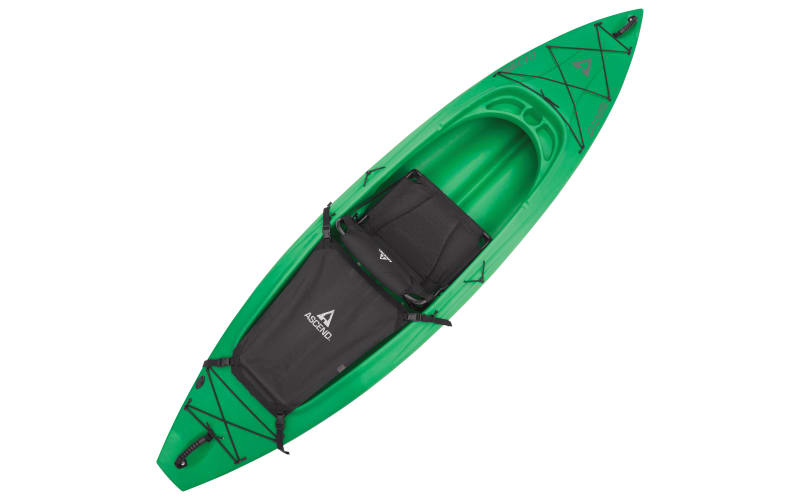
The Ascend D10 Sit-In Kayak: Image courtesy of Bass Pro Shops
Sit-On-Top Kayaks
The open deck design of sit-on-top kayaks allows for easy accessibility, earning them popularity among beginners and warm-weather kayakers.
If you are worried about your ability to get in and out of a kayak, the sit-on-top is a must-have.
The open structure allows for easy entry and exit, and their exceptional buoyancy and enhanced stability make them well-suited for kayak fishing and leisurely paddling.
However, their wider design can make them slower and less efficient in the water, and they do not provide protection from wind and water, making them less suitable for colder weather and rougher waters.

Ocean Kayak Malibu Two Tandem Sit-On-Top Recreational Kayak: Image courtesy of Amazon.com
Kayak Types and Designs
Once you move outside of the sit-in vs. sit-on-top kayak distinction, there are different models that you can choose from. Each model has its own distinct benefits.
Recreational Kayaks
Recreational kayaks are known for their versatility, stability, and affordability.
These boats are ideal for leisure paddling activities in flatwater areas such as lakes and calm rivers.
A recreational kayak strikes a balance between stability and speed, and while it may not have the bells and whistles of specialist kayaks, it is perfect for day trips and casual paddling excursions.
However, they are typically slower and not as well-equipped for long-distance trips as touring kayaks.

Evoke Vue 120 Sit-on Recreational Kayak: Image courtesy of Eastern Watersports
Touring Kayaks
Touring kayaks, including day touring kayaks, are regarded as the marathon runners in the world of kayaking.
They are designed specifically for extended travel and camping, offering quick movement through the water and straight-line tracking. A touring kayak also features large storage lockers for multi-day gear, making them ideal for those planning long journeys or adventures.
One downside here is that the cockpits can be challenging to enter and exit, particularly during portaging activities on trips.
Sea Kayaks
Sea kayaks are specifically engineered for oceanic waters and long-distance paddling. They are often longer and narrower in design. The goal here is to track straight in strong winds.
They come equipped with bulkheads and hatches at the front and rear for dry storage and flotation.

Volan 158 Sea Kayak: Image courtesy of P&H Custom Sea Kayaks
Whitewater Kayaks
Whitewater kayaks are built especially for maneuvering through river rapids. These kayaks offer high maneuverability, ease of control, and durability.
However, their poor performance in calm waters makes them a less suitable choice for leisurely paddling activities.
They come in several subtypes, including slalom kayaks, river runners, and playboats, each tailored for specific activities and maneuvering in river rapids.
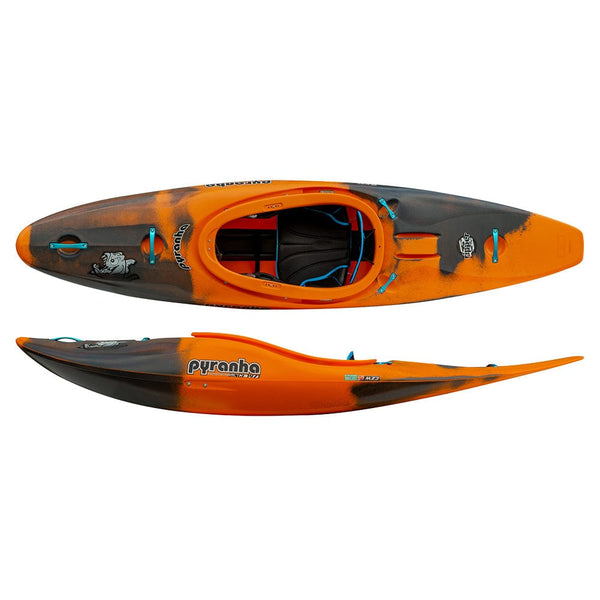
Pyranha Ripper 2 Whitewater Kayak: Image courtesy of Colorado Kayak Supply
Fishing Kayaks
Fishing kayaks are recreational models enhanced for the needs of anglers. A fishing kayak offers:
- Enhanced stability
- Rod holders
- Additional mounts for various fishing gear
- Wider designs that allow for improved vision and casting
However, these kayaks are typically slower and demand more paddling effort compared to touring kayaks.
Racing Kayaks
Speed is the defining characteristic of racing kayaks. These kayaks are long, narrow, and streamlined for high-speed paddling. They feature a lower profile to effectively cut through the water and may include a rudder for swift and precise maneuvering.
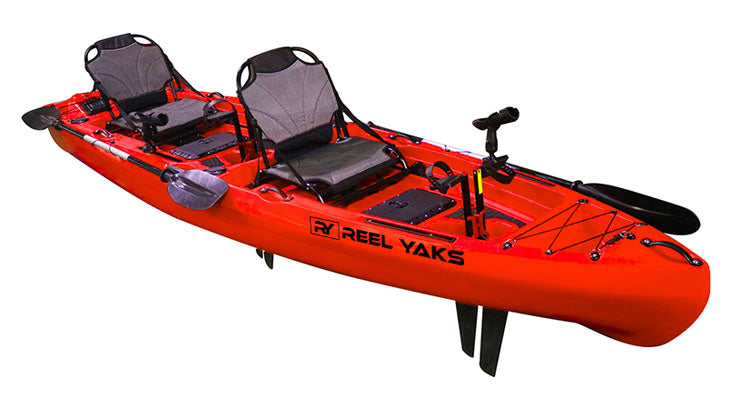
13.5′ Recon Fin Drive Double Fishing Kayak: Image courtesy of ReelYaks
Inflatable Kayaks
Inflatable kayaks are highly portable. Easy storage (by deflation) makes an inflatable kayak a practical choice for those short on space.
However, the design of an inflatable kayak tends to be less stable in high winds or rough waters, which can make paddling more challenging.
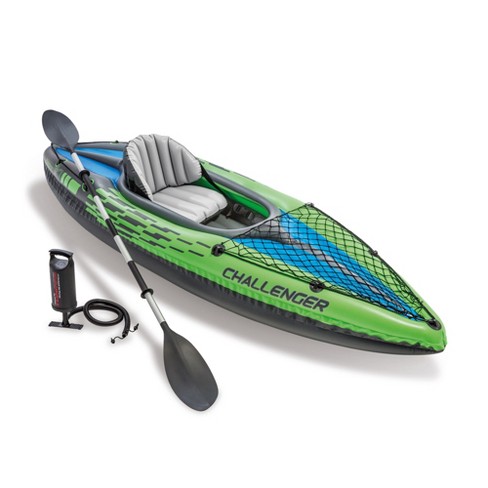
Intex Challenger K1 Inflatable Single Person Kayak: Image courtesy of Target.com
Pedal Kayaks
Pedal kayaks introduce an alternative method of propulsion.
These kayaks are propelled using the legs rather than the arms, offering hands-free operation and potentially reducing the physical effort required from the kayaker. However, pedal kayaks can be costly due to their pedal drive system and are not suitable for use in shallow waters.
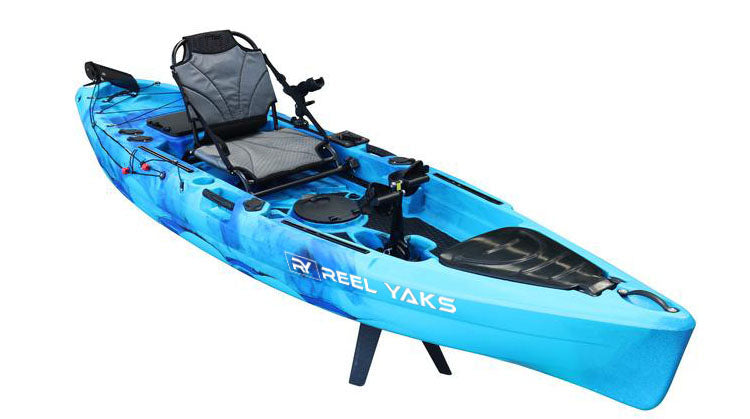
11′ Rubicon Fin Pedal Drive Fishing Kayak: Image courtesy of ReelYaks
Solo Kayaks
Designed for a single person, solo kayaks are typically lighter and more cost-effective than their tandem counterparts. They offer complete control and freedom, making them a popular choice for those who prioritize agility and responsiveness on the water.
Tandem Kayaks
Tandem kayaks allow for shared paddling, making them an apt choice for beginners or those who enjoy a companion.
However, their larger size and weight make them generally more challenging to maneuver and transport compared to solo kayaks.
Navigating Your Kayak Purchase
Choosing the right kayak is merely the initial step.
Selection of a kayak demands consideration of crucial factors like your intended use, the type of water you’ll be traversing, and your skill level.
For transport, think about whether your vehicle has a roof rack or if you’ll need a trailer.
Regardless of the kayak you purchase, it is recommended to store it properly to avoid rust, paint fading, warping, and theft. If you don’t have that space, consider renting an indoor space like a storage unit to store the vessel.
Your kayak will perfectly fit in a 5×5, 5×10, or even 10×10 storage unit if it is a bigger sea kayak. With Neighbor —a self-storage marketplace— you can find safe and budget-friendly storage spaces for your kayak, just where you need them.
Summary
Remember that the perfect kayak isn’t just about type, price, or features; it’s about the experience. Choose something versatile that checks all the boxes, whether you want to treat yourself to a lakeside cruise or take your kayak out into the ocean.
Frequently Asked Questions
What Style Kayak Is Most Stable?
A sit-inside (open-cockpit) kayak is most stable, as it lowers your center of gravity to the level of the water.
What Are the Main Differences Between Sit-in and Sit-On-Top Kayaks?
Sit-in kayaks provide greater stability and protection from the elements but can be difficult to enter and exit, whereas sit-on-top kayaks are easy to re-enter after flipping and allow effortless movement, though you will be exposed to the weather.
What Is the Most Popular Type of Kayak?
The sit-on-top kayak is the most popular type due to its stability, ease of use, and comfort.
What Kind of Kayak Is Best for Beginners?
Recreational kayaks are best for beginners, offering stability, simplicity, and suitability for calm waters. The sit-on-top kayaks also offer the most stability for those who are new and potentially unstable.







